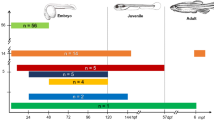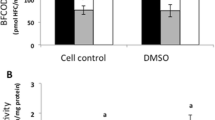Abstract
Microcystins (MC), representing >100 congeners being produced by cyanobacteria, are a hazard for aquatic species. As MC congeners vary in their toxicity, the congener composition of a bloom primarily dictates the severity of adverse effects and appears primarily to be governed by toxicokinetics, i.e., whether transport of MCs occurs via organic anion-transporting polypeptides (Oatps). Differences in observed MC toxicity in various fish species suggest differential expression of Oatp subtypes leading to varying tissue distribution of the very same MC congener within different species. The objectives of this study were the functional characterization and analysis of the tissue distribution of Oatp subtypes in zebrafish (Danio rerio) as a surrogate model for cyprinid fish. Zebrafish Oatps (zfOatps) were cloned, and the organ distribution was determined at the mRNA level. zfOatps were transiently expressed in HEK293 cells for functional characterization using the Oatp substrates estrone-3-sulfate, taurocholate and methotrexate and specific MC congeners (MC-LR, MC-RR, MC-LF and MC-LW). Novel zfOatp isoforms were isolated. Among these isoforms, the organ-specific expression of zfOatp1d1 and of members of the zfOatp1f subfamily was identified. At the functional level, zfOatp1d1, zfOatp1f2, zfOatp1f3 and zfOatp1f4 transported at least one of the Oatp substrates, and zfOatp1d1, zfOatp1f2 and zfOatp1f4 were shown to transport MC congeners. MC-LF and MC-LW were generally transported faster than MC-LR and MC-RR. The subtype-specific expression of zfOatp1d1 and of members of the zfOatp1f subfamily as well as differences in the transport of MC congeners could explain the MC congener-dependent differences in toxicity in cyprinids.





Similar content being viewed by others
Abbreviations
- OATP:
-
Organic anion-transporting polypeptide (in humans and other mammalians)
- MC:
-
Microcystin
- MC-LR:
-
Microcystin-LR
- MC-RR:
-
Microcystin-RR
- MC-LW:
-
Microcystin-LW
- MC-LF:
-
Microcystin-LF
- ser/thrPP:
-
Ser/Thr protein phosphatases
- PP1:
-
Protein phosphatase 1
- Oatp:
-
Organic anion-transporting polypeptide (in fish)
- zf:
-
Zebrafish
- h:
-
Human
- m:
-
Mouse
- ORF:
-
Open reading frame
- TCA:
-
Taurocholic acid
- E3S:
-
Estrone sulfate ammonium salt
- MTX:
-
Methotrexate disodium salt
- TMD:
-
Transmembrane domain
- HEK:
-
Human embryonic kidney
- HeLa:
-
Henrietta Lacks
- GFP:
-
Green fluorescent protein
- slco:
-
Solute carrier organic anion transporter family
References
Cai S-Y, Wang W, Soroka CJ, Ballatori N, Boyer JL (2002) An evolutionarily ancient Oatp: insights into conserved functional domains of these proteins. Am J Physiol Gastrointest Liver Physiol 282(4):G702–G710
Campos A, Vasconcelos V (2010) Molecular mechanisms of microcystin toxicity in animal cells. Int J Mol Sci 11(1):268–287
Cattori V, Hagenbuch B, Hagenbuch N et al (2000) Identification of organic anion transporting polypeptide 4 (Oatp4) as a major full-length isoform of the liver-specific transporter-1 (rlst-1) in rat liver. FEBS Lett 474(2):242–245
Cazenave J, Nores M, Miceli M, Díaz M, Wunderlin D, Bistoni M (2008) Changes in the swimming activity and the glutathione S-transferase activity of Jenynsia multidentata fed with microcystin-RR. Water Res 42(4–5):1299–1307
Choudhuri S, Ogura K, Klaassen CD (2000) Cloning of the full-length coding sequence of rat liver-specific organic anion transporter-1 (rlst-1) and a splice variant and partial characterization of the rat lst-1 gene. Biochem Biophys Res Commun 274(1):79–86
Dietrich D, Fischer A, Michel C, Hoeger S (2008) Toxin mixture in cyanobacterial blooms-a critical comparison of reality with current procedures employed in human health risk assessment. Adv Exp Med Biol 619:885
Ernst B, Hoeger S, O’Brien E, Dietrich D (2006) Oral toxicity of the microcystin-containing cyanobacterium Planktothrix rubescens in European whitefish (Coregonus lavaretus). Aquat Toxicol 79(1):31
Ernst B, Hoeger SJ, O’Brien E, Dietrich DR (2007) Physiological stress and pathology in European whitefish (Coregonus lavaretus) induced by subchronic exposure to environmentally relevant densities of Planktothrix rubescens. Aquat Toxicol 82:15–26
Ernst B, Hoeger SJ, O’Brien E, Dietrich DR (2009) Abundance and toxicity of Planktothrix rubescens in the pre-alpine Lake Ammersee, Germany. Harmful Algae 8(2):329–342
Feurstein D, Kleinteich J, Heussner AH, Stemmer K, Dietrich DR (2010) Investigation of microcystin congener-dependent uptake into primary murine neurons. Environ Health Perspect 118(10):1370–1375
Fischer W, Dietrich D (2000) Pathological and biochemical characterization of microcystin-induced hepatopancreas and kidney damage in carp (Cyprinus carpio). Toxicol Appl Pharmacol 164(1):73–81
Fischer WJ, Altheimer S, Cattori V, Meier PJ, Dietrich DR, Hagenbuch B (2005) Organic anion transporting polypeptides expressed in liver and brain mediate uptake of microcystin. Toxicol Appl Pharmacol 203(3):257–263
Fischer A, Hoeger S, Stemmer K et al (2010) The role of organic anion transporting polypeptides (OATPs/SLCOs) in the toxicity of different microcystin congeners in vitro: a comparison of primary human hepatocytes and OATP-transfected HEK293 cells. Toxicol Appl Pharmacol 245(1):9–20
Guryev V, Koudijs E, Berezikov E, Johnson SL, Plasterk H, van Eeden FJM, Cuppen E (2006) Genetic variation in the zebrafish. Genome Res 16(4):491–497
Hagenbuch B, Stieger B (2013) The SLCO (former SLC21) superfamily of transporters. Mol Aspects Med 34(2–3):396–412
Höger SJ, Schmid D, Blom JF, Ernst B, Dietrich DR (2007) Analytical and functional characterization of microcystins [Asp3] MC-RR and [Asp3, Dhb7] MC-RR: consequences for risk assessment? Environ Sci Technol 41(7):2609–2616
Kakyo M, Sakagami H, Nishio T et al (1999) Immunohistochemical distribution and functional characterization of an organic anion transporting polypeptide 2 (oatp2). FEBS Lett 445(2):343–346
Kalliokoski A, Niemi M (2009) Impact of OATP transporters on pharmacokinetics. Br J Pharmacol 158(3):693–705
Komatsu M, Furukawa T, Ikeda R et al (2007) Involvement of mitogen-activated protein kinase signaling pathways in microcystin-LR–induced apoptosis after its selective uptake mediated by OATP1B1 and OATP1B3. Toxicol Sci 97(2):407–416
Kotak B, Semalulu S, Fritz D, Prepas E, Hrudey S, Coppock R (1996) Hepatic and renal pathology of intraperitoneally administered microcystin-LR in rainbow trout (Oncorhynchus mykiss). Toxicon 34(5):517–525
Laemmli UK (1970) Cleavage of structural proteins during the assembly of the head of bacteriophage T4. Nature 227:680–685
Lu H, Choudhuri S, Ogura K et al (2008) Characterization of organic anion transporting polypeptide 1b2-null mice: essential role in hepatic uptake/toxicity of phalloidin and microcystin-LR. Toxicol Sci 103(1):35–45
Meier-Abt F, Hammann-Hänni A, Stieger B, Ballatori N, Boyer J (2007) The organic anion transport polypeptide 1d1 (Oatp1d1) mediates hepatocellular uptake of phalloidin and microcystin into skate liver. Toxicol Appl Pharmacol 218(3):274–279
Monks NR, Liu S, Xu Y, Yu H, Bendelow AS, Moscow JA (2007) Potent cytotoxicity of the phosphatase inhibitor microcystin LR and microcystin analogues in OATP1B1-and OATP1B3-expressing HeLa cells. Mol Cancer Ther 6(2):587–598
Nies AT, Niemi M, Burk O et al. (2013) Genetics is a major determinant of expression of the human hepatic uptake transporter OATP1B1, but not of OATP1B3 and OATP2B1. Genome Med 5(1):1. doi:10.1186/gm405
Popovic M, Žaja R, Smital T (2010) Organic anion transporting polypeptides (OATP) in zebrafish (Danio rerio): phylogenetic analysis and tissue distribution. Comp Biochem Physiol A: Mol Integr Physiol 155(3):327–335
Popovic M, Zaja R, Fent K, Smital T (2013) Molecular characterization of zebrafish Oatp1d1 (Slco1d1), a novel organic anion-transporting polypeptide. J Biol Chem 288(47):33894–33911
Puddick J, Prinsep MR, Wood SA, Kaufononga SA, Cary SC, Hamilton DP (2014) High levels of structural diversity observed in microcystins from microcystis CAWBG11 and characterization of six new microcystin congeners. Mar Drugs 12(11):5372–5395
Sivonen K, Jones G (1999) Cyanobacterial toxins. In: Chorus I, Bartram J (eds) Toxic cyanobacteria in water: a guide to their public health consequences, monitoring and management. Chap. 3, E & FN Spon An imprint of Routledge, London, pp 26–68. ISBN 0-419-23930-8
Steiner K, Hagenbuch B, Dietrich DR (2014) Molecular cloning and functional characterization of a rainbow trout liver Oatp. Toxicol Appl Pharmacol 280(3):534–542
Tencalla F, Dietrich D (1997) Biochemical characterization of microcystin toxicity in rainbow trout (Oncorhynchus mykiss). Toxicon 35(4):583
Towbin H, Staehelin T, Gordon J (1992) Electrophoretic transfer of proteins from polyacrylamide gels to nitrocellulose sheets: procedure and some applications. Biotechnology 24:145–149
Wang P, Hata S, Xiao Y, Murray JW, Wolkoff AW (2008) Topological assessment of oatp1a1: a 12-transmembrane domain integral membrane protein with three N-linked carbohydrate chains. Am J Physiol Gastrointest Liver Physiol 294(4):G1052–G1059
Zeck A, Weller MG, Bursill D, Niessner R (2001) Generic microcystin immunoassay based on monoclonal antibodies against Adda. Analyst 126(11):2002–2007
Acknowledgments
The financial support from the DFG Center Grant, International Max Planck Research School for Organismal Biology (IMPRS), Marie Curie International Research Staff Exchange Scheme Fellowship (PIRSES-GA-2011-295223), the National Center for Research Resources (RR021940) and the National Institute of General Medical Sciences (GM077336 and GM103549) of the National Institutes of Health are acknowledged.
Author information
Authors and Affiliations
Corresponding author
Electronic supplementary material
Below is the link to the electronic supplementary material.
Rights and permissions
About this article
Cite this article
Steiner, K., Zimmermann, L., Hagenbuch, B. et al. Zebrafish Oatp-mediated transport of microcystin congeners. Arch Toxicol 90, 1129–1139 (2016). https://doi.org/10.1007/s00204-015-1544-3
Received:
Accepted:
Published:
Issue Date:
DOI: https://doi.org/10.1007/s00204-015-1544-3




